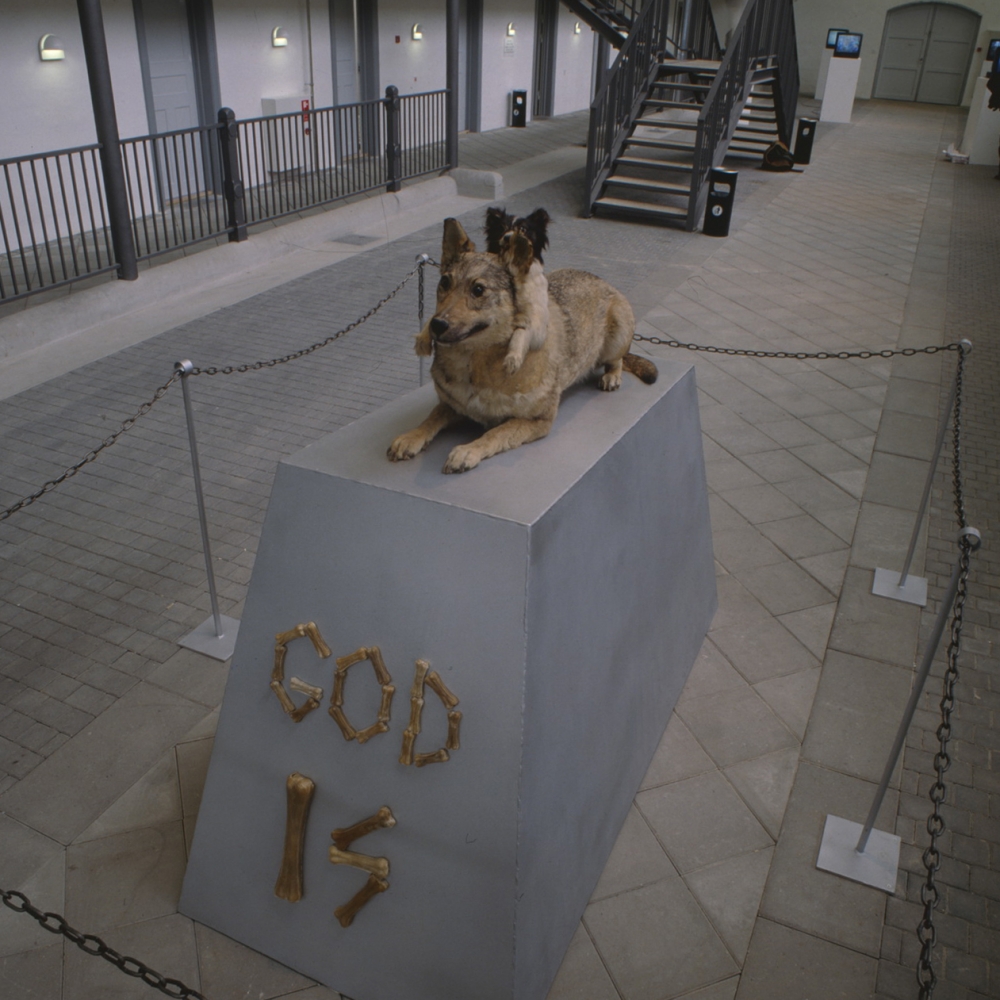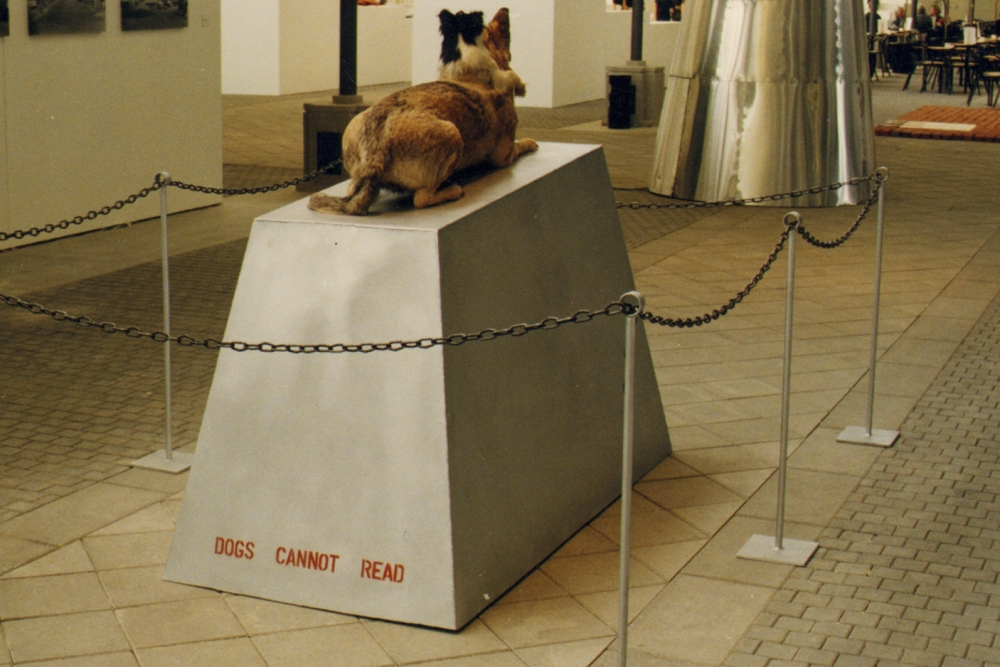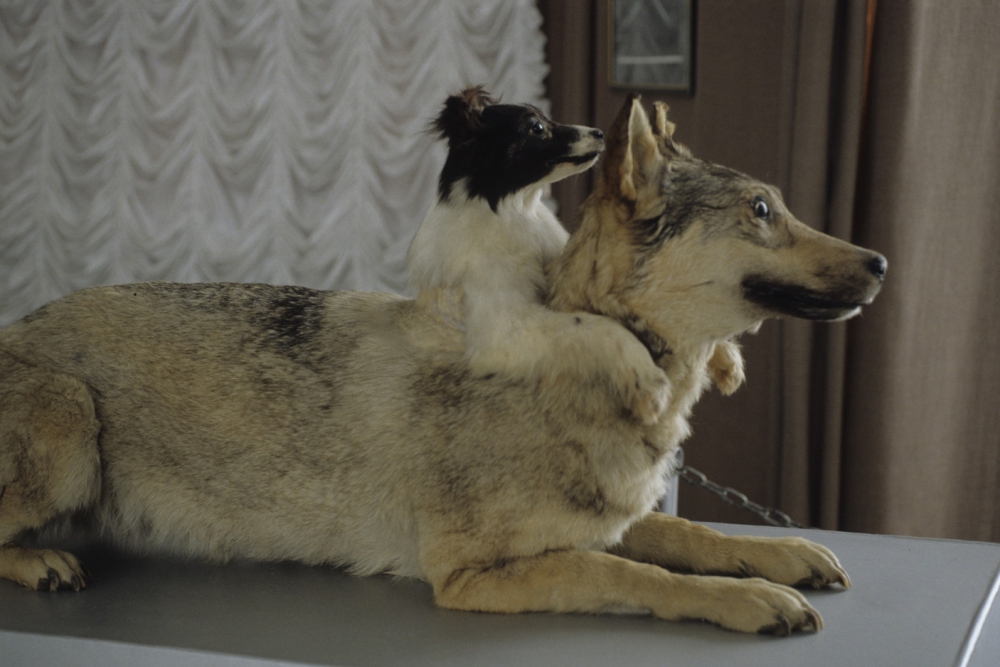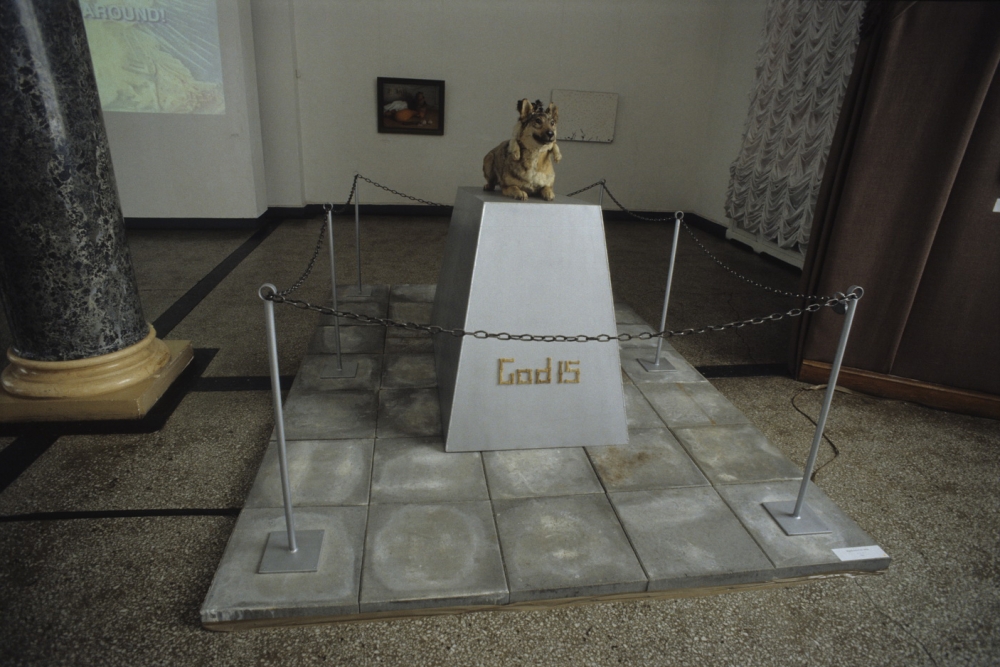God Is. Dogs Cannot Read
-

God Is. Dogs Cannot Read. 1996. Installation. Art GENDA 96, Young Artists Biennale, Oksnehalle, Copenhagen, Denmark.
In the 1930s–1950s a number of organ transplantation experiments were carried out in Soviet research labs using dogs. One of the scientists known worldwide as a pioneer of organ transplantation was Vladimir Demikhov (1916–1998). A series of experiments involving heart, lung, liver and kidney transplantation and implanting a second heart were conducted under his leadership.
One of the most shocking experiments carried out by Demikhov’s team was the creation of a two-headed dog: a puppy’s head and front legs were attached to a grown dog. Both animals were connected by blood-vessels; they shared a circulatory system, lungs and a single heart. Over the course of fifteen years from 1954, the scientist created 20 similar two-headed dogs, none of which survived longer than a month.
The scientist explained the cruel experiment with a necessity to find out if man can be saved by connecting his circulatory system to someone else’s.
The Pauls Stradiņš Medicine History Museum in Riga houses one of Vladimir Demikhov’s stuffed two-headed dogs; it was used in the “God is. Dogs Cannot Read” installation by Miķelis Fišers. -

God Is. Dogs Cannot Read. 1996. Installation. Art GENDA 96, Young Artists Biennale, Oksnehalle, Copenhagen, Denmark.
In the 1930s–1950s a number of organ transplantation experiments were carried out in Soviet research labs using dogs. One of the scientists known worldwide as a pioneer of organ transplantation was Vladimir Demikhov (1916–1998). A series of experiments involving heart, lung, liver and kidney transplantation and implanting a second heart were conducted under his leadership.
One of the most shocking experiments carried out by Demikhov’s team was the creation of a two-headed dog: a puppy’s head and front legs were attached to a grown dog. Both animals were connected by blood-vessels; they shared a circulatory system, lungs and a single heart. Over the course of fifteen years from 1954, the scientist created 20 similar two-headed dogs, none of which survived longer than a month.
The scientist explained the cruel experiment with a necessity to find out if man can be saved by connecting his circulatory system to someone else’s.
The Pauls Stradiņš Medicine History Museum in Riga houses one of Vladimir Demikhov’s stuffed two-headed dogs; it was used in the “God is. Dogs Cannot Read” installation by Miķelis Fišers. -

God Is. Dogs Cannot Read. 1998. Installation. 2nd World Wide Latvian Contemporary Art Exhibition: Attention – Fragile, State Art Museum, Rīga.
In the 1930s–1950s a number of organ transplantation experiments were carried out in Soviet research labs using dogs. One of the scientists known worldwide as a pioneer of organ transplantation was Vladimir Demikhov (1916–1998). A series of experiments involving heart, lung, liver and kidney transplantation and implanting a second heart were conducted under his leadership.
One of the most shocking experiments carried out by Demikhov’s team was the creation of a two-headed dog: a puppy’s head and front legs were attached to a grown dog. Both animals were connected by blood-vessels; they shared a circulatory system, lungs and a single heart. Over the course of fifteen years from 1954, the scientist created 20 similar two-headed dogs, none of which survived longer than a month.
The scientist explained the cruel experiment with a necessity to find out if man can be saved by connecting his circulatory system to someone else’s.
The Pauls Stradiņš Medicine History Museum in Riga houses one of Vladimir Demikhov’s stuffed two-headed dogs; it was used in the “God is. Dogs Cannot Read” installation by Miķelis Fišers. -

God Is. Dogs Cannot Read. 1998. Installation. 2nd World Wide Latvian Contemporary Art Exhibition: Attention – Fragile, State Art Museum, Rīga.
In the 1930s–1950s a number of organ transplantation experiments were carried out in Soviet research labs using dogs. One of the scientists known worldwide as a pioneer of organ transplantation was Vladimir Demikhov (1916–1998). A series of experiments involving heart, lung, liver and kidney transplantation and implanting a second heart were conducted under his leadership.
One of the most shocking experiments carried out by Demikhov’s team was the creation of a two-headed dog: a puppy’s head and front legs were attached to a grown dog. Both animals were connected by blood-vessels; they shared a circulatory system, lungs and a single heart. Over the course of fifteen years from 1954, the scientist created 20 similar two-headed dogs, none of which survived longer than a month.
The scientist explained the cruel experiment with a necessity to find out if man can be saved by connecting his circulatory system to someone else’s.
The Pauls Stradiņš Medicine History Museum in Riga houses one of Vladimir Demikhov’s stuffed two-headed dogs; it was used in the “God is. Dogs Cannot Read” installation by Miķelis Fišers.
